Thermodynamics of Imidazolium-Based Ionic Liquids for Inhibiting the Spontaneous Combustion of Sulfide Ore
Abstract
:1. Introduction
2. Experiments and Methods
2.1. Sample Preparation
2.2. Experimental Equipment and Methods
2.3. Thermodynamic Theory
2.3.1. The Most Probable Mechanism Function Inference
2.3.2. Calculation of Activation Energy and Pre-Exponential Factor
3. Results and Discussions
3.1. Effects of Ionic Liquids on the Microstructure of Sulfide Ores
3.1.1. Effect of Ionic Liquids on the Micromorphology of Sulfide Ores
3.1.2. Effect of Ionic Liquid Blocking on the Microscopic Elemental Composition of Sulfide Ores
3.2. Thermogravimetric Analysis of Ore Samples before and after Ionic Liquid Inhibition
3.3. Thermodynamic Analysis of Auto-Ignition Flame Retardant
3.3.1. Solving the Most Probable Mechanism Function Based on the Malek Method
3.3.2. Solution of Dynamic Parameters
4. Conclusions
- (1)
- The microstructural changes of the ore samples treated with ionic liquids and the control group were investigated by modern analytical techniques. The results showed that the main composition of the two samples was FeS2, and there were impurities such as SiO2 and metal oxides. No new phases were generated during the treatment of the ore samples with the ionic liquids, and the elemental composition and content of the treated ore samples were not significantly different compared with the control group. However, the surface morphology of the samples differed greatly. Compared with the original samples, the surface of the samples treated with ionic liquids was looser, showing a large particle surface, and the number of fine particles had increased;
- (2)
- The thermal behaviors of the ore samples treated with ionic liquids and the control group were systematically analyzed by thermogravimetric techniques. The spontaneous combustion reaction process of the ore samples was similar, showing three stages: the low-temperature heating stage, the oxidized spontaneous combustion stage, and the reaction end stage. The ore samples underwent an oxidation reaction during the oxidation spontaneous combustion stage. The final reaction product was Fe2O3 with SO2 gas production and intermediate products containing oxides such as FeSO4. After treatment with the ionic liquids, the ore samples’ overall oxidative spontaneous combustion reaction moved toward a higher temperature, and the ore samples became less susceptible to spontaneous combustion. This indicates that the ionic liquid has a good inhibition effect on the spontaneous combustion of sulfide ore;
- (3)
- The reaction mechanism functions and thermodynamic parameters of the ore samples treated with ionic liquids, and the control group, were obtained via the Malek, Friedman, Arch, and Coast–Redfern methods. The results show that the inhibition of the ionic liquids affected the reaction mechanism function during the oxidative spontaneous combustion stage. The activation energy of the 1FC ore samples treated with four kinds of ionic liquids increased by 3.4%, 0.9%, 2%, and 8.4%, and the activation energy of the 2FC ore samples increased by 4.7%, 1.3%, 3.8%, and 10.2%, respectively. The apparent activation energy of two ore samples increased the most after being treated with IL4, achieving the best inhibition effects.
Author Contributions
Funding
Institutional Review Board Statement
Informed Consent Statement
Data Availability Statement
Conflicts of Interest
References
- Cao, J.; Ren, S.; Wang, C.; She, J.; Jiang, Y.; Liu, Y.; Zhou, Y.; Wang, L.; Wang, J.; Wang, Y.; et al. Cadmium and lead distribution in pyrite ores: Environmental concerns over geochemically mobile fractions. Elem. Sci. Anthrop. 2021, 9, 00093. [Google Scholar] [CrossRef]
- Li, X.; Shang, Y.; Chen, Z.; Chen, X.; Niu, Y.; Yang, M.; Zhang, Y. Study of spontaneous combustion mechanism and heat stability of sulfide minerals powder based on thermal analysis. Powder Technol. 2017, 309, 68–73. [Google Scholar] [CrossRef]
- Liu, H.; Hong, R.; Xiang, C.; Lv, C.; Li, H. Visualization and analysis of mapping knowledge domains for spontaneous combustion studies. Fuel 2020, 262, 116598. [Google Scholar] [CrossRef]
- Yang, F.; Lai, Y.; Song, Y. Determination of the influence of pyrite on coal spontaneous combustion by thermodynamics analysis. Process. Saf. Environ. Protect. 2019, 129, 163–167. [Google Scholar] [CrossRef]
- Hong, R.; Liu, H.; Xiang, C.; Song, Y.M.; Lv, C. Visualization and analysis of mapping knowledge domain of oxidation studies of sulfide ores. Environ. Sci. Pollut. Res. 2020, 27, 5809–5824. [Google Scholar] [CrossRef] [PubMed]
- Liu, H.; Wu, C.; Shi, Y. Locating method of fire source for spontaneous combustion of sulfide ores. J. Cent. South Univ. Technol. 2011, 18, 1034–1040. [Google Scholar] [CrossRef]
- Li, Z.-J.; Shi, D.-P.; Wu, C.; Wang, X.-L. Infrared thermography for prediction of spontaneous combustion of sulfide ores. Trans. Nonferrous Met. Soc. China 2012, 22, 3095–3102. [Google Scholar] [CrossRef]
- Stachulak, J.S. Computerized fire monitoring, criteria, techniques and experience at inco limited. CIM Bull. 1990, 83, 59–67. [Google Scholar]
- Tang, J.H.; Feng, Y.X.; Wu, Z.L.; Zhang, S.Y.; Sarkodie, E.K.; Jin, H.M.; Yuan, R.L.; Pan, W.; Liu, H.W. Optimization studies on biological desulfurization of sulfide ore using response surface methodology. Minerals 2021, 11, 15. [Google Scholar] [CrossRef]
- Pan, W.; Wu, C.; Li, Z.-J.; Shi, Y.; Yang, Y.-P. Nonlinear characteristics of induced spontaneous combustion process of sulfide ores. J. Cent. South Univ. 2016, 23, 3284–3292. [Google Scholar] [CrossRef]
- Liu, H.; Wang, Z.; Zhong, J.; Xie, Z. Early detection of spontaneous combustion disaster of sulphide ore stockpiles. Teh. Vjesn. 2015, 22, 1579–1587. [Google Scholar]
- Xiang, C.; Liu, H.; Mu, J.; Lang, Z.; Wang, H.; Nie, R.; Kong, F. Thermodynamic model and kinetic compensation effect of spontaneous combustion of sulfur concentrates. ACS Omega 2020, 5, 20618–20629. [Google Scholar] [CrossRef] [PubMed]
- Liu, H.; Xiang, C.; Hong, R.; Song, Y.; Jin, K.; Zhu, K.; Yang, C.; Lv, C. Thermal behavior and kinetics of sulfide concentrates. Therm. Sci. 2019, 23, 2801–2811. [Google Scholar] [CrossRef] [Green Version]
- Mitishova, N.A. Development of technological recommendations for ensuring fire and explosion safety during underground development of pyrite ore deposits. Proc. Tula States Univ. Sci. Earth 2021, 4, 165–177. [Google Scholar]
- Kaihuan, Z.; Fuchuan, J. Research on intrinsic safety method for open-pit mining. Procedia Eng. 2012, 43, 453–458. [Google Scholar] [CrossRef] [Green Version]
- Deng, J.; Lue, H.F.; Xiao, Y.; Wang, C.P.; Shu, C.M.; Jiang, Z.G. Thermal effect of ionic liquids on coal spontaneous combustion. J. Therm. Anal. Calorim. 2019, 138, 3415–3424. [Google Scholar] [CrossRef]
- Xi, X.; Shi, Q.L.; Jiang, S.G.; Zhang, W.Q.; Wang, K.; Wu, Z.Y. Study on the effect of ionic liquids on coal spontaneous combustion characteristic by microstructure and thermodynamic. Process. Saf. Environ. Protect. 2020, 140, 190–198. [Google Scholar] [CrossRef]
- Wang, L.-Y.; Xu, Y.-L.; Jiang, S.-G.; Yu, M.-G.; Chu, T.-X.; Zhang, W.-Q.; Wu, Z.-Y.; Kou, L.-W. Imidazolium based ionic liquids affecting functional groups and oxidation properties of bituminous coal. Saf. Sci. 2012, 50, 1528–1534. [Google Scholar] [CrossRef]
- Cui, C.; Jiang, S.; Wang, K.; Zheng, S.; Li, M.; Zhang, W.; Tang, H. Effects of ionic liquid concentration on coal low-temperature oxidation. Energy Sci. Eng. 2019, 7, 2165–2179. [Google Scholar] [CrossRef] [Green Version]
- Zheng, X.; Zhang, S.; Li, W.; Gong, M.; Yin, L. Experimental and theoretical studies of two imidazolium-based ionic liquids as inhibitors for mild steel in sulfuric acid solution. Corros. Sci. 2015, 95, 168–179. [Google Scholar] [CrossRef]
- Liu, H.; Hong, R.; Xiang, C.; Wang, H.; Li, Y.; Xu, G.; Chang, P.; Zhu, K. Thermal decomposition kinetics analysis of the oil sludge using model-based method and model-free method. Process. Saf. Environ. Protect. 2020, 141, 167–177. [Google Scholar] [CrossRef]
- Xi, Z.; Shan, Z.; Li, M.; Wang, X. Analysis of coal spontaneous combustion by thermodynamic methods. Combust. Sci. Technol. 2021, 193, 2305–2330. [Google Scholar] [CrossRef]
- Hu, R.; Shi, Q. Thermal Analysis Kinetics; Science Press: Beijing, China, 2008. [Google Scholar]
- Selvaratnam, M.; Garn, P.D. Kinetics of thermal decompositions-improvement in data treatment. J. Am. Ceram. Soc. 1976, 59, 376. [Google Scholar] [CrossRef]
- Liu, H.; Xiang, C.; Mu, J.; Yao, J.; Ye, D.; Jin, K.; Lang, Z. Thermodynamic model and kinetic compensation effect of oil sludge pyrolysis based on thermogravimetric analysis. Therm. Sci. 2022, 26, 259–272. [Google Scholar] [CrossRef]
- Luo, L.; Guo, X.; Zhang, Z.; Chai, M.; Rahman, M.; Zhang, X.; Cai, J. Insight into pyrolysis kinetics of lignocellulosic biomass: Isoconversional kinetic analysis by the modified friedman method. Energy Fuels 2020, 34, 4874–4881. [Google Scholar] [CrossRef]
- Vyazovkin, S.; Burnham, A.K.; Criado, J.M.; Pérez-Maqueda, L.A.; Popescu, C.; Sbirrazzuoli, N. ICTAC Kinetics Committee recommendations for performing kinetic computations on thermal analysis data. Thermochim. Acta 2011, 520, 1–19. [Google Scholar] [CrossRef]
- Liu, H.; Zhao, S.; Xie, Z.; Zhu, K.; Xu, X.; Ding, X.; Glowacz, A. Investigation of the pyrophoric tendency of the powder of corrosion products in an oil tank. Powder Technol. 2018, 339, 296–305. [Google Scholar] [CrossRef]
- Liu, H.; Hong, R.; Lang, Z.; Yao, J.; Ye, D.; Shan, J.; Liu, X. Evaluation of the spontaneous combustion tendency of corrosion products in oil tanks based on TOPSIS methodologies. J. Loss Prev. Process. Ind. 2021, 71, 104475. [Google Scholar] [CrossRef]
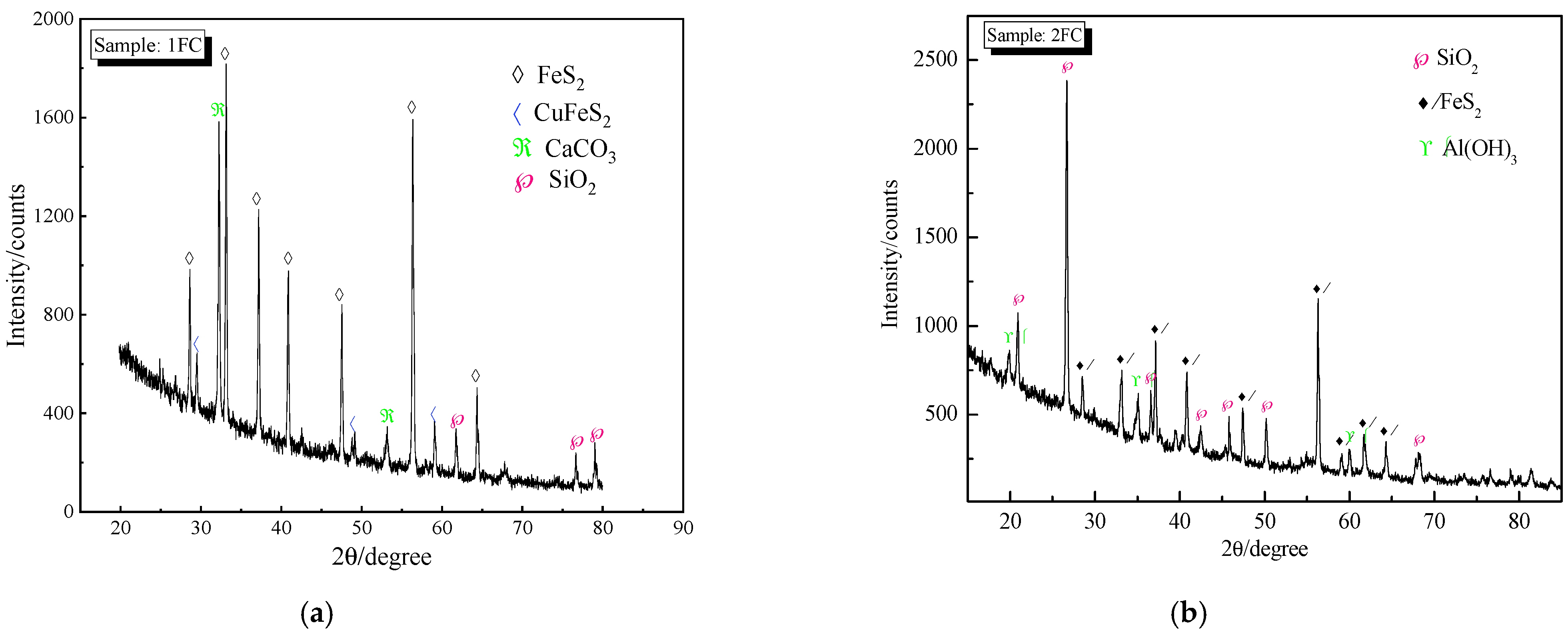
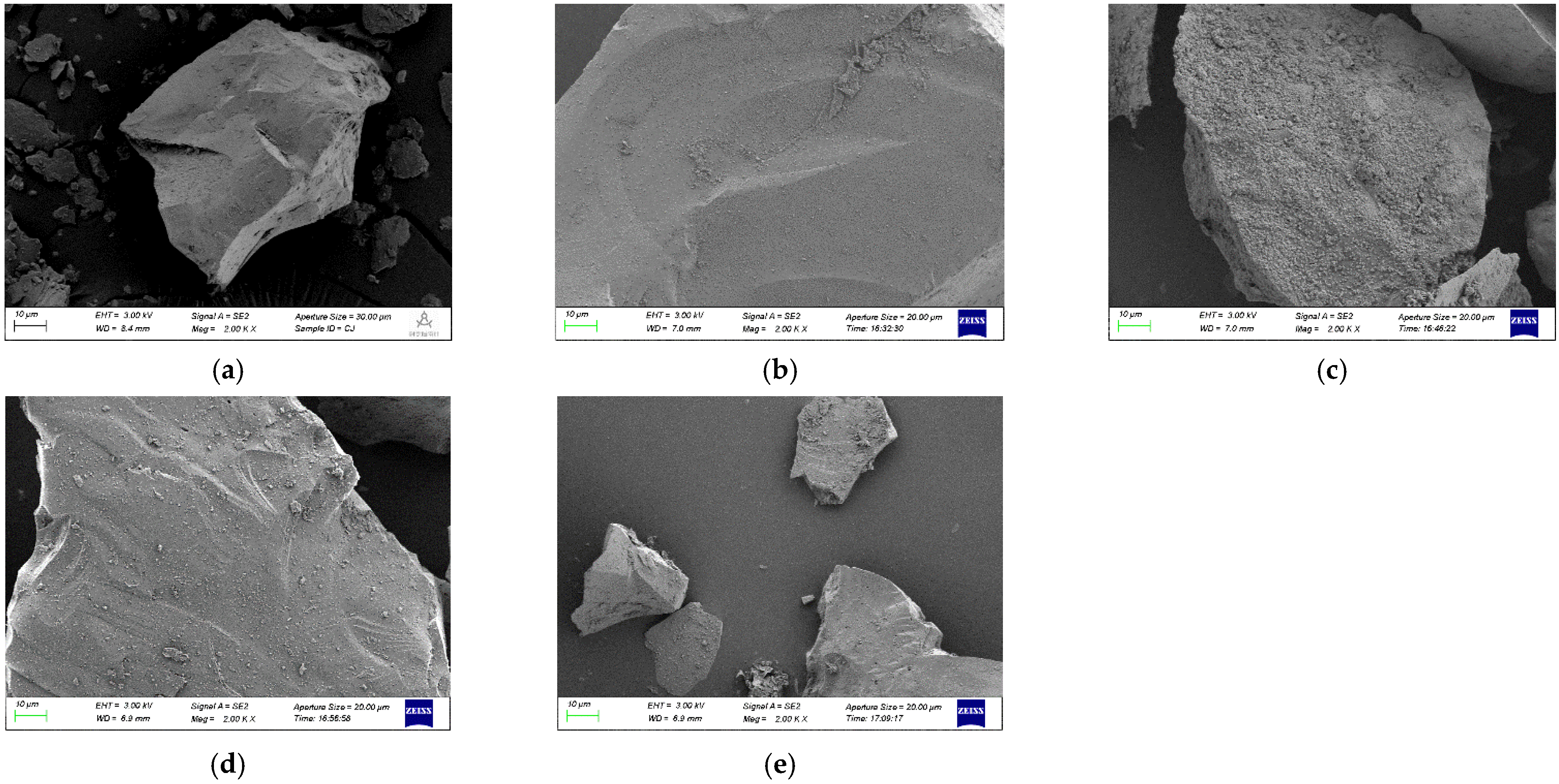
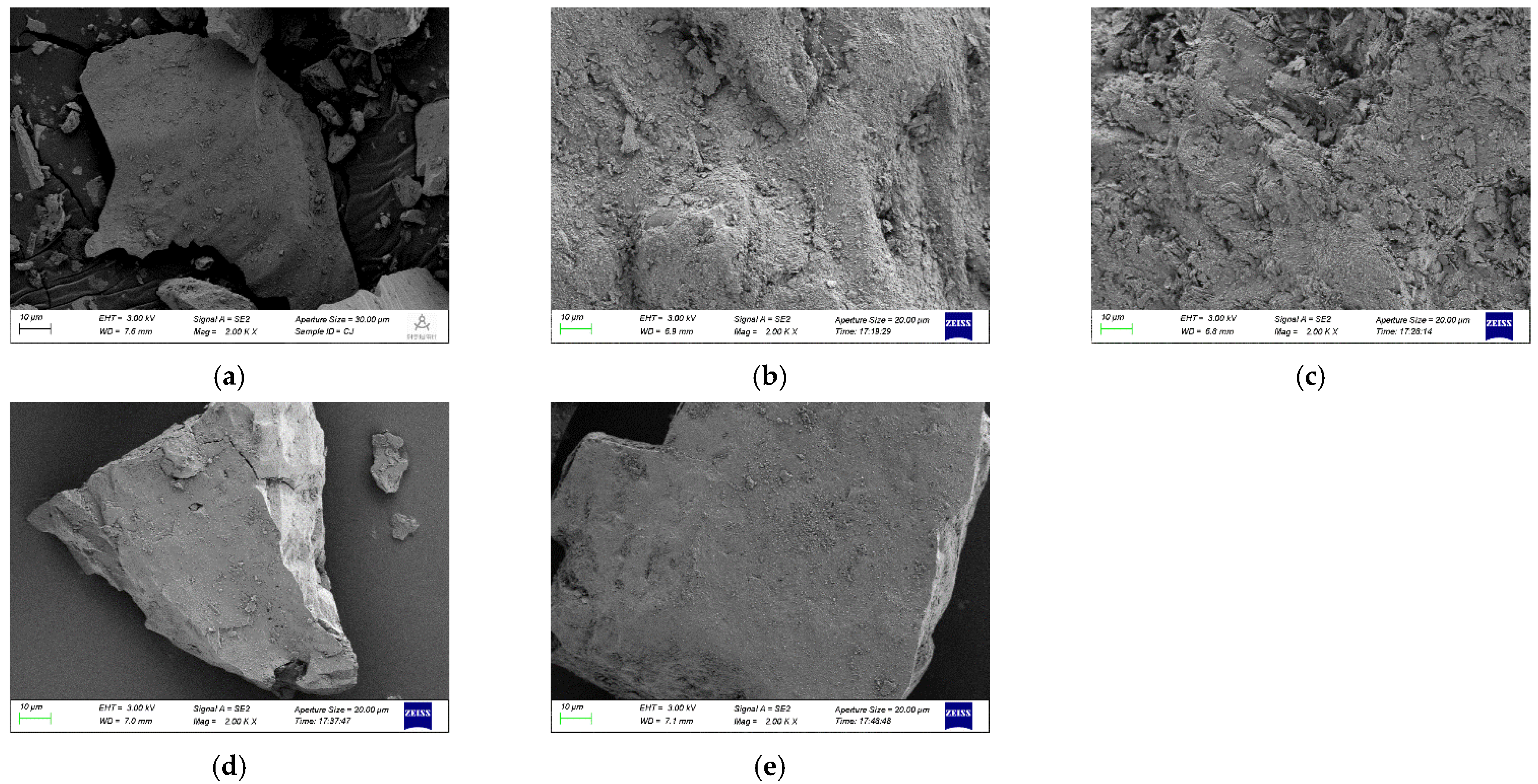
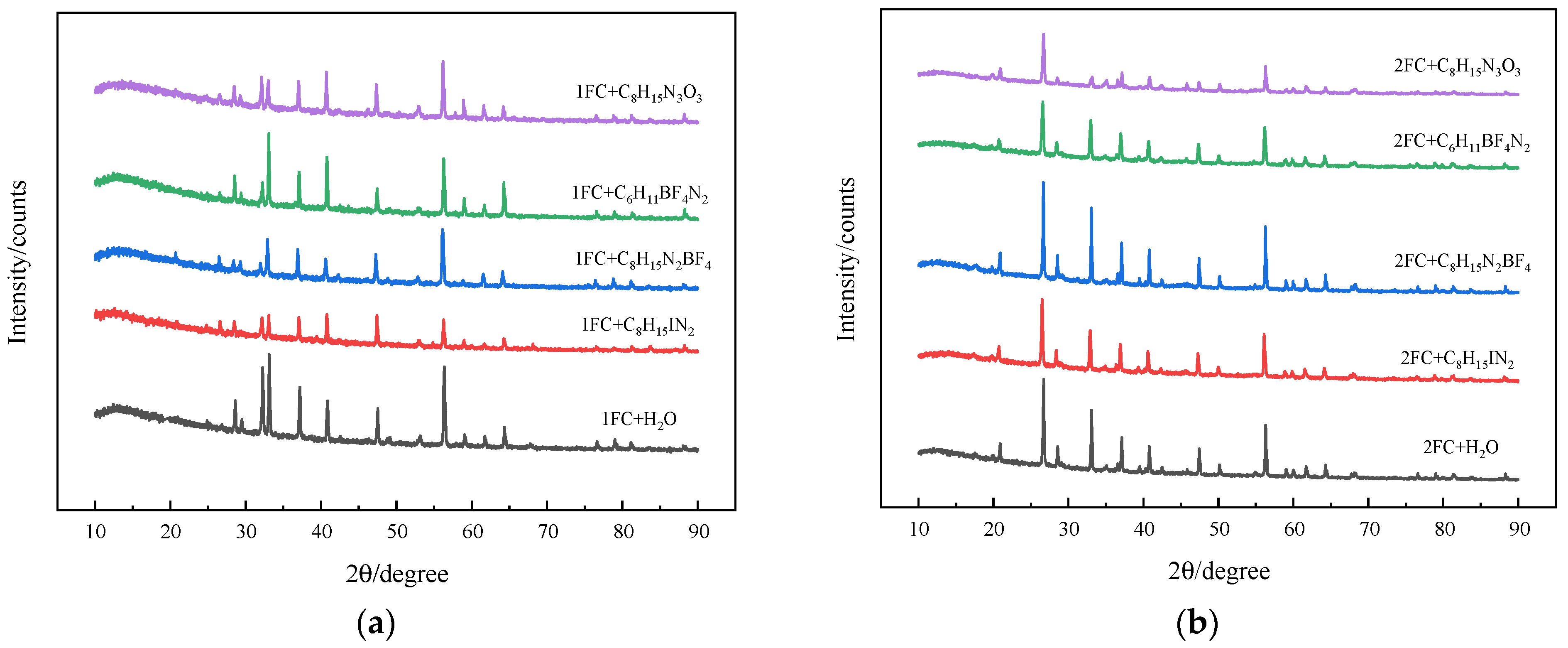
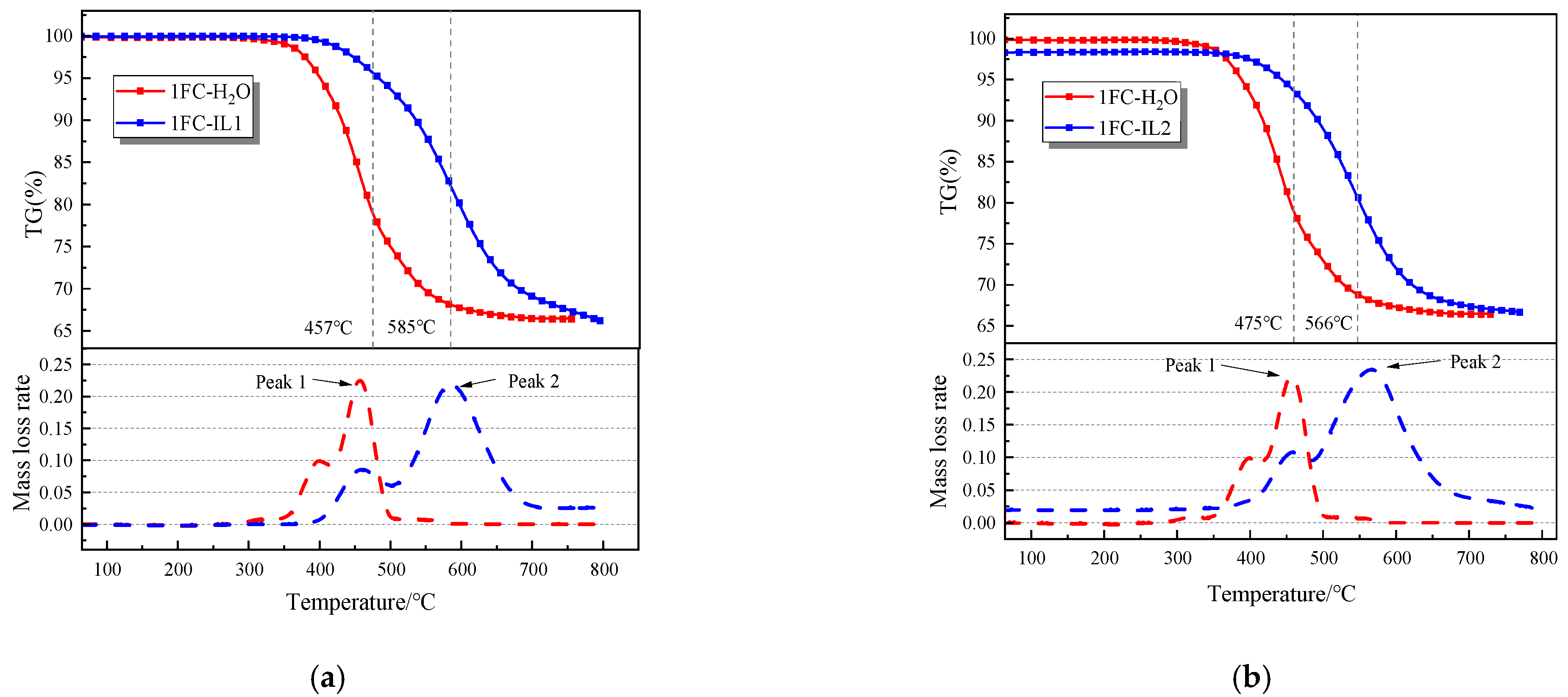
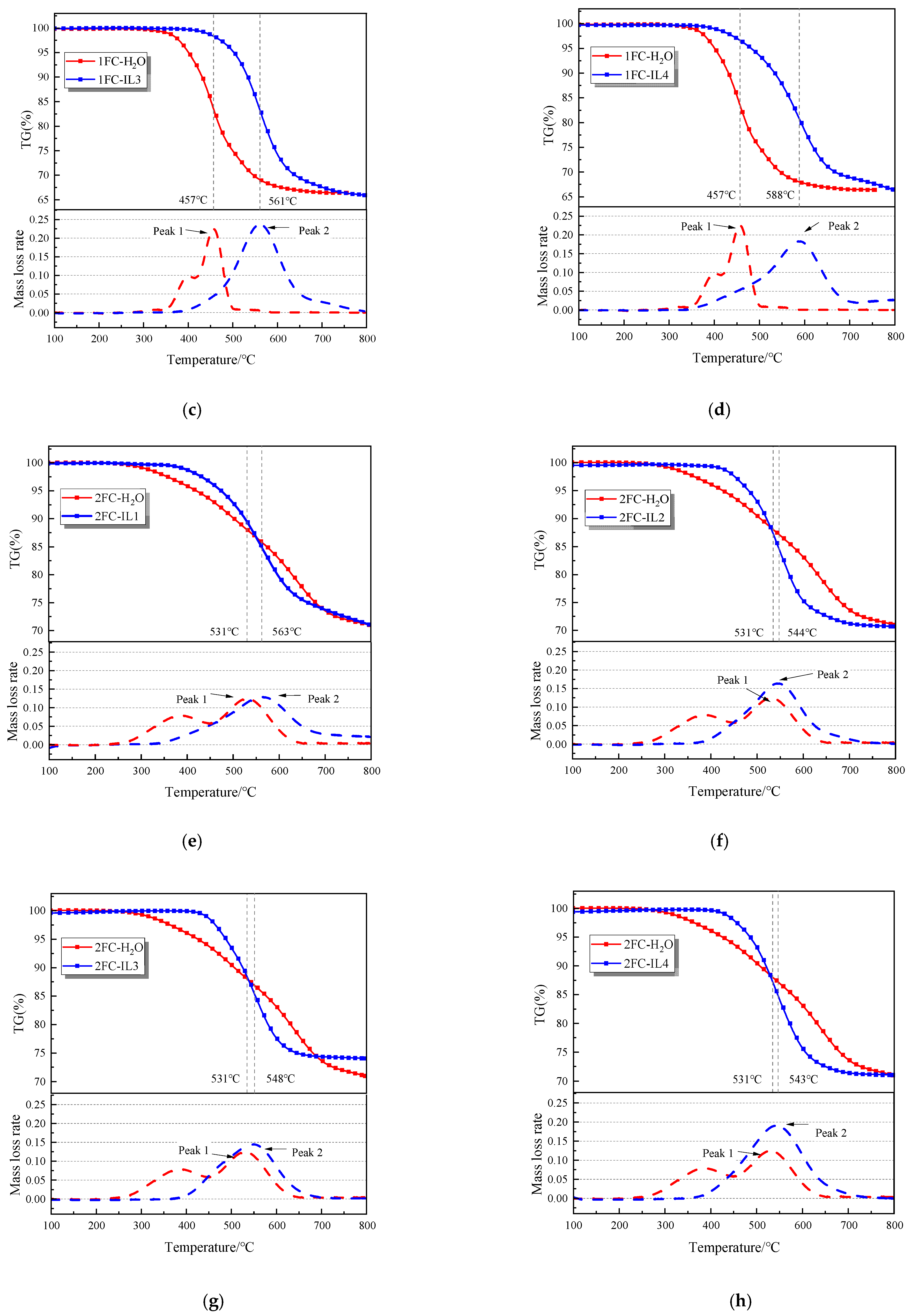
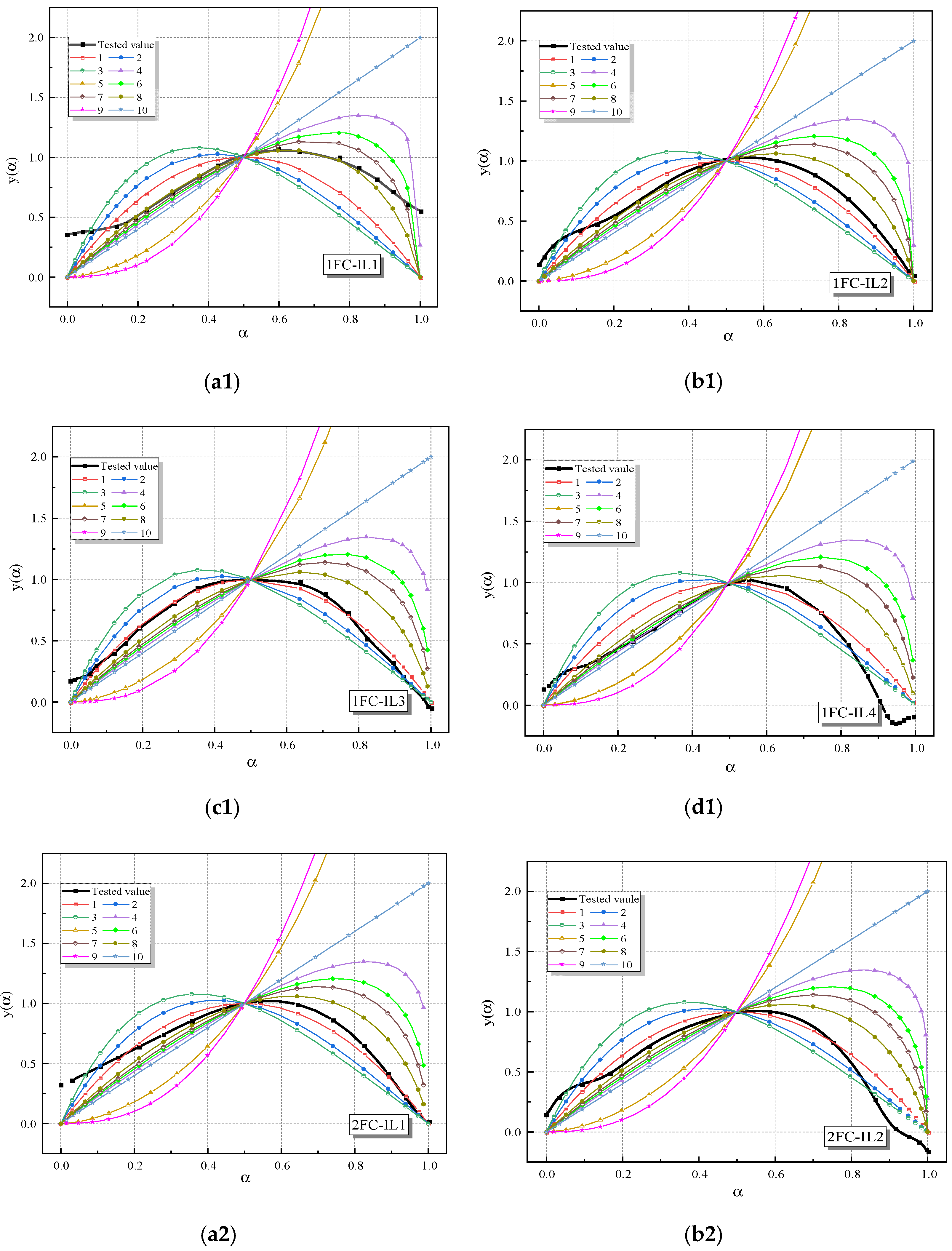

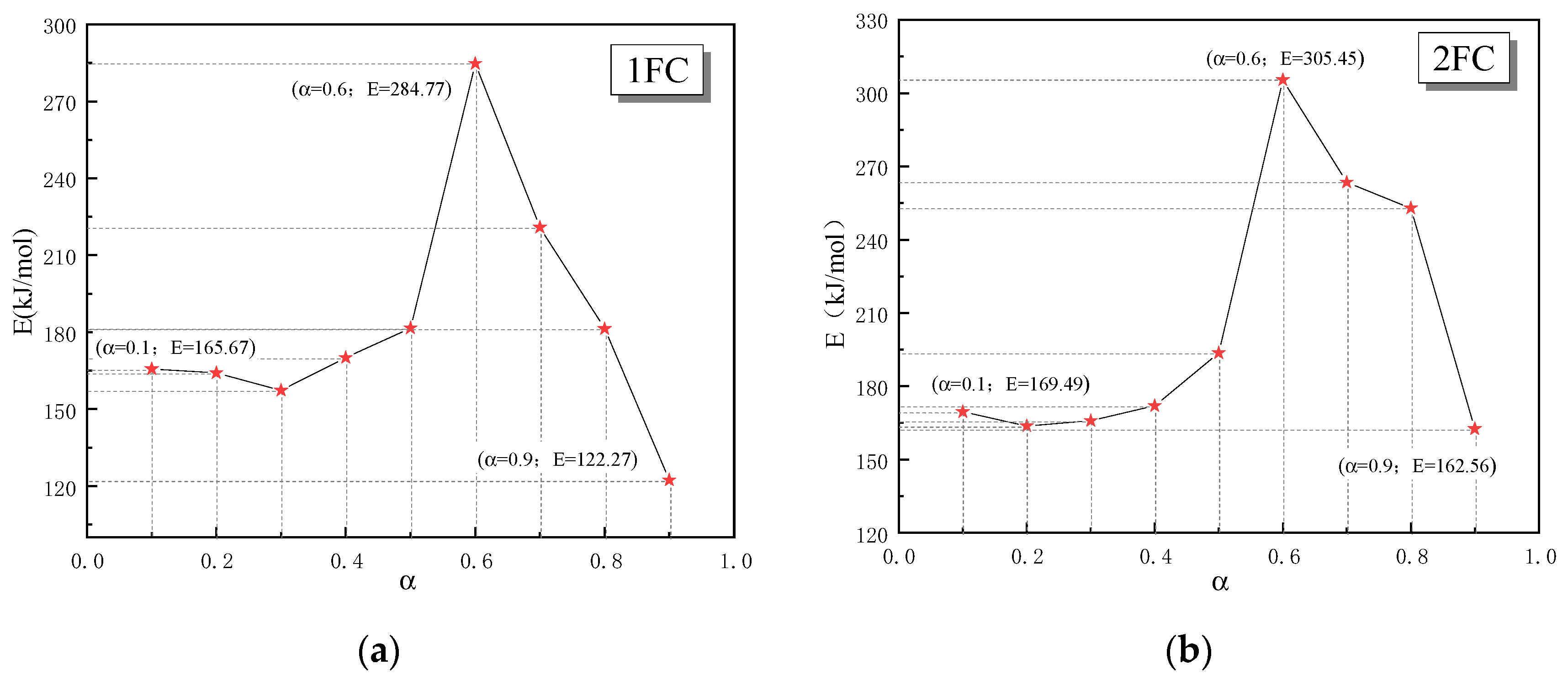
| Sample | C | S | Fe | F | N | O | Cu | Ca | Al |
|---|---|---|---|---|---|---|---|---|---|
| 1FC | 4.55 | 45.12 | 43.47 | 1.38 | 0.89 | 2.71 | 1.05 | 0.20 | 0.63 |
| 2FC | 4.47 | 42.14 | 42.04 | 1.39 | 1.84 | 5.75 | 0.87 | 0.11 | 1.39 |
| Number of Ionic Liquids | Chemical Expression | Melting Point of Ionic Liquids | Storage Condition | CAS Number |
|---|---|---|---|---|
| IL1 | C8H15IN2 | −72 °C | Protection from light, inert gas, room temperature | 65039-05-6 |
| IL2 | C8H15BF4N2 | −71 °C | Below 30 °C | 174501-65-6 |
| IL3 | C6H11BF4N2 | 15 °C | Sealed dry, room temperature | 143314-16-3 |
| IL4 | C8H15N3O3 | 18 °C | Ventilation, low temperature, drying | 179075-88-8 |
| Number | Function Name | Mechanism | f(α) | G(α) |
|---|---|---|---|---|
| 1 | Chemical Reaction | n = 2 | (1 − α)2 | (1 − α)−1 − 1 |
| 2 | Chemical Reaction | n = 3 | (1 − α)3 | [(1 − α)−2 − 1]/2 |
| 3 | Chemical Reaction | n = 4 | (1 − α)4 | [(1 − α)−3 − 1]/3 |
| 4 | Valensi equation | Two-dimensional diffusion | −1/ln(1 − α) | α + (1 − α)[ln(1 − α)] |
| 5 | Ginstling-Brounshtein equation | Three-dimensional diffusion | 3/2[(1 − α)1/3 − 1]−1 | 1 − 2α/3 − (1 − α)2/3 |
| 6 | Shrinkage geometrical column | Two-Dimensional Phase Interfacial Reaction | 2(1 − α)1/2 | 1 − (1 − α)1/2 |
| 7 | Shrinkage geometrical spherical | Three-Dimensional Phase Interfacial Reaction | 3(1 − α)2/3 | 1 − (1 − α)1/3 |
| 8 | Mample law | Nucleation and growth | 1 − α | −ln(1 − α) |
| 9 | Power law | n = 1/3 | 3α2/3 | α1/3 |
| 10 | Power law | n = 1/4 | 4α3/4 | α1/4 |
| Sample | C | S | Fe | F | N | I | O | Cu | Ca | Al |
|---|---|---|---|---|---|---|---|---|---|---|
| 1FC-IL1 | 5.44 | 40.10 | 48.87 | 0.85 | 1.75 | 0.27 | 0.47 | 0.88 | 0.35 | 1.02 |
| 1FC-IL2 | 8.23 | 45.86 | 40.92 | 2.26 | 1.00 | 0.00 | 0.52 | 0.54 | 0.09 | 0.58 |
| 1FC-IL3 | 8.33 | 43.66 | 39.66 | 2.34 | 0.33 | 0.04 | 3.53 | 0.49 | 0.07 | 1.55 |
| 1FC-IL4 | 6.24 | 46.78 | 42.48 | 1.58 | 0.02 | 0.00 | 1.56 | 0.43 | 0.03 | 0.88 |
| 2FC-IL1 | 2.78 | 45.37 | 42.61 | 2.38 | 2.79 | 0.00 | 1.99 | 0.78 | 0.11 | 1.19 |
| 2FC-IL2 | 5.29 | 44.48 | 41.73 | 2.65 | 1.71 | 0.00 | 2.43 | 0.66 | 0.09 | 0.96 |
| 2FC-IL3 | 4.45 | 45.33 | 44.87 | 1.31 | 0.92 | 0.00 | 1.86 | 0.21 | 0.04 | 1.01 |
| 2FC-IL4 | 4.51 | 46.37 | 39.95 | 2.55 | 2.14 | 0.00 | 2.77 | 0.24 | 0.03 | 1.44 |
| Sample | F1 | F2 | F3 | F4 | F5 | F6 | F7 | F8 | F9 | F10 |
|---|---|---|---|---|---|---|---|---|---|---|
| 1FC-IL1 | 0.7719 | 0.5978 | 0.4533 | 0.8625 | 0.2527 | 0.9220 | 0.9440 | 0.9368 | 0.3298 | 0.6094 |
| 1FC-IL2 | 0.9734 | 0.9036 | 0.8254 | 0.5349 | 0.2949 | 0.7431 | 0.8341 | 0.9380 | 0.2296 | 0.0822 |
| 1FC-IL3 | 0.9819 | 0.9603 | 0.9141 | 0.2885 | 0.3945 | 0.5581 | 0.6886 | 0.8505 | 0.4296 | 0.1476 |
| 1FC-IL4 | 0.9094 | 0.9027 | 0.8652 | 0.0417 | 0.6110 | 0.2792 | 0.4611 | 0.7039 | 0.5869 | 0.3623 |
| 1FC-H2O | 0.7832 | 0.6386 | 0.5287 | 0.6777 | 0.1365 | 0.8563 | 0.9041 | 0.9198 | 0.0351 | 0.2435 |
| 2FC-IL1 | 0.9573 | 0.9175 | 0.8579 | 0.2472 | 0.4816 | 0.5210 | 0.6611 | 0.8350 | 0.4999 | 0.2199 |
| 2FC-IL2 | 0.9367 | 0.9421 | 0.9143 | 0.0118 | 0.6847 | 0.3596 | 0.5270 | 0.7426 | 0.6543 | 0.4271 |
| 2FC-IL3 | 0.9492 | 0.9180 | 0.8747 | 0.2625 | 0.4658 | 0.5565 | 0.6929 | 0.8502 | 0.4810 | 0.1947 |
| 2FC-IL4 | 0.9594 | 0.9586 | 0.9289 | 0.0827 | 0.6046 | 0.4187 | 0.5834 | 0.7858 | 0.5980 | 0.3421 |
| 2FC-H2O | 0.8128 | 0.9070 | 0.9243 | 0.3056 | 0.1273 | 0.3933 | 0.4597 | 0.5786 | 0.1652 | 0.1787 |
| Sample | E/(kJ·mol−1) | lnA |
|---|---|---|
| 1FC-IL1 | 294.64 | 43.36 |
| 1FC-IL2 | 287.32 | 37.21 |
| 1FC-IL3 | 290.56 | 39.76 |
| 1FC-IL4 | 308.75 | 48.93 |
| 1FC-H2O | 284.77 | 32.54 |
| 2FC-IL1 | 319.84 | 52.26 |
| 2FC-IL2 | 309.58 | 41.23 |
| 2FC-IL3 | 317.23 | 32.59 |
| 2FC-IL4 | 336.66 | 43.34 |
| 2FC-H2O | 305.45 | 38.75 |
Publisher’s Note: MDPI stays neutral with regard to jurisdictional claims in published maps and institutional affiliations. |
© 2022 by the authors. Licensee MDPI, Basel, Switzerland. This article is an open access article distributed under the terms and conditions of the Creative Commons Attribution (CC BY) license (https://creativecommons.org/licenses/by/4.0/).
Share and Cite
Tian, J.; Pan, K.; Lang, Z.; Huang, R.; Sun, W.; Chu, H.; Ren, H.; Dong, L.; Li, Y.; Wang, H.; et al. Thermodynamics of Imidazolium-Based Ionic Liquids for Inhibiting the Spontaneous Combustion of Sulfide Ore. Sustainability 2022, 14, 7915. https://doi.org/10.3390/su14137915
Tian J, Pan K, Lang Z, Huang R, Sun W, Chu H, Ren H, Dong L, Li Y, Wang H, et al. Thermodynamics of Imidazolium-Based Ionic Liquids for Inhibiting the Spontaneous Combustion of Sulfide Ore. Sustainability. 2022; 14(13):7915. https://doi.org/10.3390/su14137915
Chicago/Turabian StyleTian, Jiaxin, Kai Pan, Zhihui Lang, Rui Huang, Wenrui Sun, Hanyu Chu, Haotong Ren, Lingyu Dong, Yawen Li, Haining Wang, and et al. 2022. "Thermodynamics of Imidazolium-Based Ionic Liquids for Inhibiting the Spontaneous Combustion of Sulfide Ore" Sustainability 14, no. 13: 7915. https://doi.org/10.3390/su14137915
APA StyleTian, J., Pan, K., Lang, Z., Huang, R., Sun, W., Chu, H., Ren, H., Dong, L., Li, Y., Wang, H., & Liu, H. (2022). Thermodynamics of Imidazolium-Based Ionic Liquids for Inhibiting the Spontaneous Combustion of Sulfide Ore. Sustainability, 14(13), 7915. https://doi.org/10.3390/su14137915







